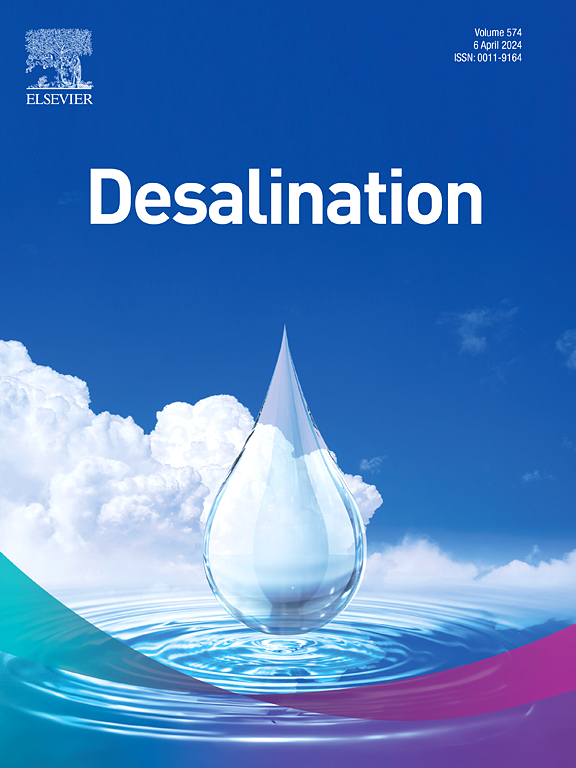二氧化氯对聚酰胺膜的ph依赖性影响:性能、表面表征和降解机制
IF 9.8
1区 工程技术
Q1 ENGINEERING, CHEMICAL
引用次数: 0
摘要
众所周知,二氧化氯(ClO2)可以降解聚酰胺(PA)膜,但在不同pH条件下这种降解的程度和机制尚不清楚。在这项研究中,我们系统地评估了不同pH值(4、10和12)下ClO2暴露(100 ppm)对两类PA膜的性能和物理化学性质的影响:基于间苯二胺(MPD)的膜(NF90和BW30)和基于哌嗪的膜(NF270)。在酸性条件下(pH 4),所有膜的纯水通量变化最小。交叉流过滤试验表明,NF90膜的通量适度降低(~3 LMH),阻盐率增加(从84%增加到92%),这反映了在酸性条件下形成的氯类诱导的n -氯化反应的结构重排。相比之下,碱性条件(pH值12)导致了广泛的降解,证明了通量的显著增加(NF90约为10倍,BW30为24倍)和盐排斥的急剧减少(NF90从81%降至0%)。这种降解是由于ClO2分子对去质子化酰胺氮的直接亲电攻击,导致PA层的大量去除。基于哌嗪的NF270膜在所有pH条件下都具有良好的ClO2降解能力,性能变化很小。这些结果突出了膜化学结构在决定对ClO2处理的弹性中的关键作用,并为工业脱盐过程中选择合适的膜和操作条件提供了定量依据。本文章由计算机程序翻译,如有差异,请以英文原文为准。

pH-dependent effects of chlorine dioxide on polyamide membranes: Performance, surface characterization, and degradation mechanisms
Chlorine dioxide (ClO2) is known to degrade polyamide (PA) membranes, but the extent and mechanism of this degradation under varying pH conditions remain poorly understood. In this study, we systematically evaluated the impact of ClO2 exposure (100 ppm) across different pH values (4, 10, and 12) on the performance and physicochemical properties of two classes of PA membranes: m-phenylenediamine (MPD)-based membranes (NF90 and BW30) and a piperazine-based membrane (NF270). Under acidic conditions (pH 4), minimal changes in pure water flux were observed for all membranes. Cross-flow filtration tests indicated a moderate decrease in flux (~3 LMH) and an increase in salt rejection (from 84 % to 92 %) for NF90 membranes, reflecting structural rearrangement from N-chlorination reactions induced by chlorine species formed under acidic conditions. In contrast, alkaline conditions (pH 12) resulted in extensive degradation, evidenced by significant flux increases (approximately 10-fold for NF90 and 24-fold for BW30) and drastic reductions in salt rejection (from 81 % to 0 % for NF90). This degradation was due to direct electrophilic attacks by ClO2 molecules on deprotonated amide nitrogens, causing substantial removal of the PA layer. The piperazine-based NF270 membrane demonstrated excellent resistance to ClO2 degradation across all pH conditions, exhibiting only minimal performance changes. These results highlight the critical role of membrane chemical structure in determining resilience to ClO2 treatment and provide a quantitative basis for selecting appropriate membranes and operating conditions in industrial desalination processes.
求助全文
通过发布文献求助,成功后即可免费获取论文全文。
去求助
来源期刊

Desalination
工程技术-工程:化工
CiteScore
14.60
自引率
20.20%
发文量
619
审稿时长
41 days
期刊介绍:
Desalination is a scholarly journal that focuses on the field of desalination materials, processes, and associated technologies. It encompasses a wide range of disciplines and aims to publish exceptional papers in this area.
The journal invites submissions that explicitly revolve around water desalting and its applications to various sources such as seawater, groundwater, and wastewater. It particularly encourages research on diverse desalination methods including thermal, membrane, sorption, and hybrid processes.
By providing a platform for innovative studies, Desalination aims to advance the understanding and development of desalination technologies, promoting sustainable solutions for water scarcity challenges.
 求助内容:
求助内容: 应助结果提醒方式:
应助结果提醒方式:


